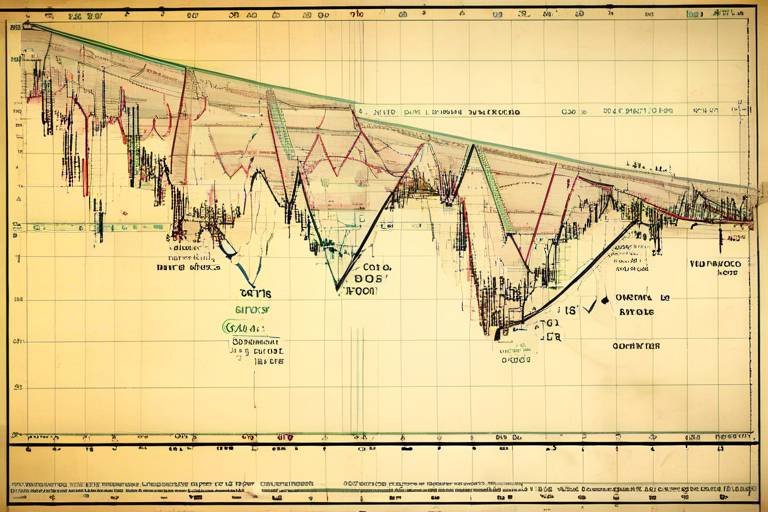Developing a Long-Term Investment Strategy
In the world of finance, developing a long-term investment strategy is akin to crafting a well-thought-out map for a journey. Just as a traveler needs a clear destination and a route to get there, investors must establish clear financial goals and a plan to reach them. This article delves into the essential components of a successful long-term investment strategy, including goal setting, risk assessment, asset allocation, and the paramount importance of patience and discipline in achieving your financial objectives. By understanding these elements, you can navigate the often turbulent waters of investing with confidence and purpose.
Establishing clear investment goals is crucial for any long-term strategy. Think of your financial objectives as the North Star guiding your investment ship. Whether you're aiming for a comfortable retirement, funding your children's education, or simply accumulating wealth, defining these goals is the first step in your investment journey. It's not just about the numbers; it's about aligning your goals with your risk tolerance. For instance, if you're saving for a short-term goal, like a vacation, you might opt for safer investments. However, if you're planning for retirement decades away, you may be more inclined to take on higher risks for potentially greater rewards.
Understanding your risk tolerance is vital for developing an effective investment strategy. It's like knowing how much turbulence you can handle on a flight. Are you the type who clutches the armrest during every bump, or do you sit back and enjoy the ride? Evaluating your comfort level with market fluctuations will significantly impact your investment choices and overall financial plan. Ask yourself: how would you react if your investment dropped 20% in value? Would you panic and sell, or would you hold on, trusting in the long-term potential of your investments?
Investors face various types of risks that can affect their portfolios. Here are some key risks to consider:
- Market Risk: The risk of losing money due to a decline in the market.
- Credit Risk: The risk that a borrower will default on a loan or bond.
- Interest Rate Risk: The risk that changes in interest rates will affect the value of your investments.
Each of these risks can impact investment performance over the long term, and understanding them is crucial for any investor.
Market volatility can significantly impact investment returns, much like the ups and downs of a roller coaster. While the thrill of potential gains can be exhilarating, the fear of losses can be daunting. To manage and mitigate the effects of market fluctuations on your long-term investments, consider strategies such as dollar-cost averaging or diversifying your portfolio across various asset classes. By spreading your investments, you can reduce the impact of a poor-performing asset on your overall portfolio.
Inflation is another crucial factor that can erode your purchasing power over time. Imagine having a dollar today that buys you a candy bar, but in ten years, that same dollar only gets you half a candy bar. This is why it’s essential to account for inflation in your long-term investment strategy. Choose growth-oriented assets that have the potential to outpace inflation. Stocks, real estate, and commodities are examples of assets that can provide a hedge against inflation.
Asset allocation is a key component of a long-term investment strategy. Think of it as building a balanced meal; you wouldn’t only eat pasta every day, right? You need a variety of nutrients from different food groups. Similarly, diversifying your portfolio across various asset classes—such as stocks, bonds, and real estate—can help manage risk and optimize returns. The right mix will depend on your investment goals, risk tolerance, and time horizon.
Long-term investing requires patience and discipline, much like tending to a garden. You plant the seeds, water them, and wait for them to grow. It’s easy to get distracted by the latest market trends or to panic during downturns, but staying committed to your investment strategy is crucial. Avoid emotional decisions, and maintain a long-term perspective during market fluctuations. Remember, the stock market is a marathon, not a sprint.
Keeping abreast of market trends and economic indicators is essential for informed decision-making. Continuous learning is crucial for successful long-term investing. Subscribe to financial news outlets, read investment blogs, and attend webinars to stay updated. The more you know, the better equipped you'll be to make sound investment choices.
Regularly reviewing and adjusting your investment strategy is important for staying aligned with your goals. Life changes, and so should your investment plan. Whether it’s a new job, a growing family, or a shift in financial goals, reassessing your portfolio ensures it remains on track for long-term success. Set a schedule to review your investments—perhaps annually or semi-annually—and make necessary adjustments to keep your strategy relevant.
Q: What is the best investment strategy for beginners?
A: Start with a diversified portfolio that includes a mix of stocks and bonds, and consider using low-cost index funds.
Q: How often should I review my investment strategy?
A: It's advisable to review your strategy at least once a year or whenever there are significant changes in your life or financial situation.
Q: What should I do if the market crashes?
A: Stay calm and avoid making impulsive decisions. Stick to your long-term strategy and consider this an opportunity to buy quality investments at lower prices.

Understanding Investment Goals
Establishing clear investment goals is crucial for any long-term strategy. Think of your investment goals as a roadmap guiding you through the often turbulent waters of the financial market. Without a clear destination, it’s easy to drift off course or get lost in the noise of market fluctuations. So, what exactly should you consider when defining your financial objectives? First and foremost, it’s essential to identify what you’re investing for. Are you saving for retirement, funding your child’s education, or simply looking to accumulate wealth? Each of these goals will require a different approach and timeline.
Once you’ve identified your primary objectives, the next step is to align them with your risk tolerance. This is where things can get a bit tricky. Your risk tolerance is essentially your comfort level with the ups and downs of the market. For instance, if you’re investing for retirement and have a solid 20-30 years to go, you might be more willing to take on higher risks for potentially greater returns. On the other hand, if you’re saving for a home purchase in the next few years, you might prefer a more conservative approach to protect your principal investment.
Setting SMART (Specific, Measurable, Achievable, Relevant, Time-bound) goals can be incredibly beneficial. Here’s how you can break it down:
- Specific: Define exactly what you want to achieve. Instead of saying, "I want to save for retirement," specify, "I want to save $1 million for retirement."
- Measurable: Ensure that your goals can be tracked. For instance, aim to contribute $500 monthly to your retirement account.
- Achievable: Set realistic goals based on your current financial situation. Consider what you can reasonably accomplish within your time frame.
- Relevant: Ensure your goals align with your overall financial plan and life objectives.
- Time-bound: Set a deadline. For example, "I want to reach my retirement savings goal by age 65."
It’s also vital to periodically revisit and adjust your goals as life circumstances change. Major life events such as marriage, having children, or changing jobs can significantly impact your financial objectives. Regularly assessing your goals ensures that they remain relevant and achievable.
In summary, understanding your investment goals is the cornerstone of a successful long-term investment strategy. It’s not just about picking the right stocks or bonds; it’s about having a clear vision of what you want to achieve and how you plan to get there. By taking the time to define your goals, align them with your risk tolerance, and adopt a SMART approach, you’ll be better equipped to navigate the complexities of investing and ultimately reach your financial objectives.

Assessing Risk Tolerance
Understanding your risk tolerance is vital for developing an effective investment strategy. It's like knowing how spicy you like your food; if you dive into a dish that’s too hot, you might end up regretting it. Similarly, if you invest in assets that are too risky for your comfort level, you could find yourself in a world of financial pain. Risk tolerance is essentially your ability and willingness to endure fluctuations in the value of your investments. This can be influenced by several factors, including your financial situation, investment goals, and even your personality.
To assess your risk tolerance, consider asking yourself the following questions:
- What is my investment time horizon? (Short-term or long-term?)
- How would I feel if my investments dropped by 10% or even 20%?
- Am I investing for a specific goal, such as retirement or a child's education?
- What is my current financial situation, including income, savings, and expenses?
It's also important to recognize that risk tolerance isn't a static trait; it can evolve over time. As you age, your financial goals may shift, and so might your comfort with risk. For instance, a younger investor might be willing to take on more risk in exchange for potentially higher returns, while someone nearing retirement may prefer safer investments to preserve capital. Therefore, regularly revisiting your risk tolerance is crucial.
There are various tools and questionnaires available online that can help you assess your risk tolerance more formally. These tools typically ask a series of questions to evaluate your investment style and preferences. Based on your responses, they categorize you into different risk profiles, such as conservative, moderate, or aggressive. Understanding your profile can guide you in making informed investment decisions that align with your comfort level.
In conclusion, assessing your risk tolerance is not just a one-time exercise; it’s an ongoing process that requires reflection and adjustment. By understanding your risk tolerance, you can create a well-structured investment strategy that not only aims for growth but also keeps you comfortable during market ups and downs. Remember, investing should be a journey, not a rollercoaster ride!
- What is risk tolerance? Risk tolerance is your ability and willingness to endure fluctuations in the value of your investments.
- How can I assess my risk tolerance? You can assess your risk tolerance by reflecting on your financial situation, investment goals, and emotional responses to market changes.
- Does risk tolerance change over time? Yes, risk tolerance can evolve based on changes in your financial situation, age, and investment objectives.
- Are there tools to help me assess my risk tolerance? Yes, many online tools and questionnaires can help evaluate your risk profile based on your responses to specific questions.

Types of Risk
When it comes to investing, understanding the various you may encounter is essential for crafting a robust long-term investment strategy. Risks are inherent in the financial markets, and being aware of them can significantly influence your investment decisions. Let’s delve into some of the most common types of risks that could affect your portfolio.
First off, there’s market risk, which is the risk of losses due to factors that affect the overall performance of the financial markets. This can include economic downturns, political instability, or even natural disasters. Market risk is often measured by the volatility of an asset, which reflects how much the price of an investment fluctuates. For instance, stocks generally have higher volatility compared to bonds, meaning they can offer greater potential returns but also come with increased risk.
Next, we have credit risk. This type of risk arises when a borrower fails to repay a loan or meet contractual obligations. For investors, this often pertains to bonds. If a company or government entity defaults on its debt, bondholders may lose some or all of their investment. Understanding the creditworthiness of the issuer is crucial here, as it can help you avoid potential pitfalls in your investment strategy.
Another significant risk is interest rate risk. This risk primarily affects fixed-income investments, like bonds. When interest rates rise, the value of existing bonds typically falls since new bonds are issued at higher rates, making the older ones less attractive. For long-term investors, it’s essential to consider how changes in interest rates can impact your portfolio, especially if you hold a substantial amount of fixed-income assets.
To illustrate these risks more clearly, let’s take a look at the following table:
| Type of Risk | Description | Example |
|---|---|---|
| Market Risk | Risk of losses due to overall market decline. | Stock market crash affecting all equities. |
| Credit Risk | Risk of a borrower defaulting on a loan. | Company defaults on its bond payments. |
| Interest Rate Risk | Risk of investment value decline due to rising interest rates. | Bonds losing value when new bonds offer higher rates. |
Lastly, it’s worth mentioning inflation risk. This risk refers to the possibility that the return on your investments won’t keep pace with inflation, leading to a decrease in purchasing power over time. For example, if your investments yield a 5% return but inflation is at 3%, your real return is only 2%. To combat inflation risk, many investors look for growth-oriented assets that can potentially outpace inflation.
In conclusion, recognizing these various types of risks is crucial for any investor. By understanding market, credit, interest rate, and inflation risks, you can make more informed decisions and tailor your investment strategy to mitigate these risks effectively. Always remember that the key to successful investing lies not just in the potential for high returns, but also in managing the risks that can derail your financial goals.
- What is market risk? Market risk is the possibility of experiencing losses due to factors that affect the overall performance of the financial markets.
- How can I mitigate credit risk? You can mitigate credit risk by diversifying your investments and researching the creditworthiness of issuers.
- Why is interest rate risk important? Interest rate risk is important because it can affect the value of fixed-income investments like bonds, especially in a rising interest rate environment.
- What is inflation risk? Inflation risk is the risk that your investment returns will not keep pace with inflation, reducing your purchasing power over time.

Market Volatility
Market volatility is like a roller coaster ride—exciting yet nerve-wracking. It refers to the rapid and often unpredictable changes in the price of assets in the financial markets. For investors, understanding market volatility is crucial because it can significantly impact investment returns. Imagine you’ve put your hard-earned money into stocks, and suddenly the market takes a nosedive. Your heart races, and you might feel the urge to sell everything to avoid further losses. But hold on! Before making any hasty decisions, it’s essential to grasp the nature of volatility and how to manage it effectively.
Volatility can stem from various factors, including economic data releases, geopolitical events, and changes in interest rates. These elements can create an environment where prices fluctuate wildly. For instance, during an economic downturn, stock prices may drop sharply as investors panic. Conversely, during a booming economy, prices may soar as optimism drives buying activity. Understanding these dynamics can help you remain calm and make informed decisions rather than succumbing to fear.
So, how can you manage the impacts of market volatility on your investments? Here are a few strategies to consider:
- Diversification: Spread your investments across different asset classes, such as stocks, bonds, and real estate. This approach can help cushion your portfolio against market swings.
- Stay the Course: Remember your long-term investment goals. Market fluctuations are often temporary, and having a solid plan can keep you focused on the bigger picture.
- Invest in Quality: Choose high-quality companies with strong fundamentals. These firms are often more resilient during market downturns.
Additionally, it’s essential to maintain a well-thought-out investment strategy that includes regular assessments of your portfolio. By doing this, you can ensure that you are not overly exposed to high-risk assets that may amplify the effects of volatility. Think of your investment portfolio as a well-balanced meal; you wouldn’t want to consume only one food group, right? A mix of different investments can lead to a healthier financial future.
In conclusion, while market volatility can be daunting, it also presents opportunities for savvy investors. By understanding its nature and employing sound strategies, you can navigate the ups and downs with confidence. Remember, investing is a marathon, not a sprint. Stay informed, stay patient, and let your investments grow over time.
- What causes market volatility? Market volatility can be caused by economic indicators, political events, changes in interest rates, and investor sentiment.
- How can I protect my investments from volatility? Diversifying your portfolio, investing in quality assets, and maintaining a long-term perspective can help mitigate risks associated with market volatility.
- Is volatility bad for long-term investors? Not necessarily. While volatility can cause short-term fluctuations in portfolio value, long-term investors can often benefit from lower prices during market downturns.

Inflation Risk
Inflation risk is a crucial factor to consider when developing a long-term investment strategy. Simply put, inflation is the rate at which the general level of prices for goods and services rises, eroding purchasing power over time. Imagine you have $100 today; in a few years, that same $100 might only buy you what $80 can buy today if inflation rises significantly. This gradual decline in purchasing power can sneak up on investors, making it essential to account for it in your investment plans.
To effectively combat inflation risk, it's important to choose growth-oriented assets that have the potential to outpace inflation. For instance, stocks historically have provided returns that exceed inflation rates over the long term, making them a popular choice among investors looking to preserve their purchasing power. Conversely, fixed-income investments, like bonds, may not keep pace with inflation, resulting in a net loss of value over time. Thus, understanding the balance between different asset classes is vital.
Here are some strategies to mitigate inflation risk:
- Invest in Equities: Stocks have historically provided returns that surpass inflation over the long haul.
- Real Assets: Consider investing in real estate or commodities, as these tend to hold their value during inflationary periods.
- Inflation-Protected Securities: Look into Treasury Inflation-Protected Securities (TIPS) which are designed specifically to protect against inflation.
It's also essential to regularly assess your portfolio to ensure it remains aligned with your inflation expectations. This means being proactive rather than reactive. If inflation trends upward, you might need to adjust your asset allocation to include more growth-oriented investments. Always remember that the key to long-term success lies in staying informed and flexible in your approach.
In summary, inflation risk is a silent but potent enemy of your investment returns. By incorporating growth-oriented assets and regularly reviewing your strategy, you can effectively safeguard your investments against the erosive effects of inflation. The goal is to not just preserve your wealth but to grow it in real terms, ensuring that your financial future remains bright, regardless of economic fluctuations.
What is inflation risk? Inflation risk refers to the potential loss of purchasing power due to rising prices over time, which can diminish the value of your investments.
How can I protect my investments from inflation? You can protect your investments by including growth-oriented assets like stocks, real estate, and inflation-protected securities in your portfolio.
Why is it important to consider inflation in my long-term investment strategy? Considering inflation is crucial because it affects the real returns on your investments, helping you maintain your purchasing power and achieve your financial goals.

Creating an Asset Allocation Plan
When it comes to building a long-term investment strategy, one of the most crucial steps is . Think of asset allocation as the foundation of your investment house; it determines how your portfolio is structured and how risk is distributed among different asset classes. By effectively diversifying your investments, you can manage risk while aiming for optimal returns. But how do you go about creating a plan that suits your financial goals and risk tolerance?
First, it's essential to understand the different types of asset classes available. Typically, these include stocks, bonds, real estate, and cash equivalents. Each asset class behaves differently and comes with its own set of risks and rewards. For instance, stocks generally offer higher returns but are more volatile, while bonds tend to provide more stability but lower returns. By spreading your investments across these classes, you can cushion your portfolio against market fluctuations.
Next, consider your investment horizon—the length of time you plan to invest before needing to access your funds. If you’re young and saving for retirement, you might afford to take on more risk by allocating a larger portion of your portfolio to stocks. Conversely, if you’re nearing retirement, a more conservative approach with a higher allocation to bonds may be prudent. Here’s a simple table to illustrate how asset allocation might look based on different age groups:
| Age Group | Stocks (%) | Bonds (%) | Real Estate (%) | Cash Equivalents (%) |
|---|---|---|---|---|
| 20-30 | 80 | 10 | 5 | 5 |
| 30-40 | 70 | 20 | 5 | 5 |
| 40-50 | 60 | 30 | 5 | 5 |
| 50+ | 50 | 40 | 5 | 5 |
Now, once you've established your target asset allocation, it's vital to reassess your portfolio regularly. Market conditions change, and so do your personal circumstances. Life events such as marriage, having children, or changing jobs can all impact your financial goals and risk tolerance. By revisiting your asset allocation, you can ensure it remains aligned with your current situation.
Finally, remember that creating an asset allocation plan is not a one-time task; it's an ongoing process. As market dynamics shift and your financial goals evolve, your allocation strategy should adapt accordingly. This flexibility is key to navigating the ever-changing landscape of investing. So, take the time to craft a thoughtful asset allocation plan, and you'll be well on your way to achieving your long-term financial objectives!
- What is asset allocation? Asset allocation is the process of distributing investments across various asset classes to manage risk and optimize returns.
- Why is asset allocation important? It helps to mitigate risk by diversifying investments, which can lead to more stable returns over time.
- How often should I review my asset allocation? Regular reviews are recommended, especially after major life changes or significant market movements.
- Can I change my asset allocation as I age? Absolutely! It's common to adjust your asset allocation based on your age, risk tolerance, and financial goals.

The Importance of Patience and Discipline
When it comes to long-term investing, patience and discipline are your best friends. Imagine planting a seed; you can’t rush it to grow. You water it, give it sunlight, and wait patiently for it to bloom. Similarly, your investments require time to mature. In a world where instant gratification is the norm, the idea of waiting for your investments to pay off can feel daunting. But here’s the kicker: successful investors know that the real magic happens over time.
Many investors jump into the market with excitement, only to panic when they see their stocks dip. It’s like a rollercoaster ride—thrilling at first, but the sudden drops can be terrifying. This emotional rollercoaster often leads to hasty decisions, such as selling off assets during a downturn. Remember, the market is cyclical; it has its ups and downs. Those who maintain their course and stick to their strategy, even when the going gets tough, often come out on the other side with significant gains.
Discipline also plays a crucial role in sticking to your investment plan. It’s easy to get swayed by the latest market trends or hot tips from friends. However, a well-thought-out investment strategy is built on research and analysis, not on fleeting emotions or trends. Establishing a clear plan and adhering to it, despite market noise, is what separates successful investors from the rest. Here are a few key points to keep in mind:
- Stick to Your Strategy: Once you’ve outlined your investment goals and asset allocation, stick to it. Reassess only when necessary.
- Avoid Emotional Decisions: Fear and greed can lead to poor choices. Keep a cool head and remember your long-term objectives.
- Regular Check-Ins: While discipline is key, staying informed is equally important. Schedule regular reviews of your portfolio to ensure you’re on track.
Another aspect of discipline is understanding the importance of rebalancing. As your investments grow, some may outperform others, leading to an imbalance in your portfolio. Regularly rebalancing your portfolio ensures that you maintain your desired level of risk and return. Think of it like tuning a musical instrument—if one string is out of tune, the whole melody can be off. Keeping your investments in harmony is essential for long-term success.
In the end, the journey of investing is akin to a marathon rather than a sprint. It requires a steady pace, endurance, and the ability to push through tough times. By cultivating patience and discipline, you’ll not only enhance your investment strategy but also build a solid foundation for achieving your financial goals. So, the next time you feel the urge to make a hasty decision, take a deep breath, remind yourself of your long-term objectives, and stay the course.
Q1: Why is patience important in investing?
A1: Patience allows your investments to grow over time. Markets fluctuate, and waiting for the right moment can lead to significant gains.
Q2: How can I develop discipline in my investment strategy?
A2: Establish a clear investment plan, stick to it, and avoid making emotional decisions based on market volatility.
Q3: What should I do if my investments are not performing well?
A3: Instead of panicking, review your strategy. It might be necessary to reassess your goals or rebalance your portfolio.
Q4: How often should I review my investment portfolio?
A4: Regular check-ins, such as quarterly or biannually, can help you stay aligned with your financial goals and make necessary adjustments.

Staying Informed
In the fast-paced world of investing, is not just an option; it's a necessity. Imagine trying to navigate a ship through stormy seas without a compass or map. That's what investing can feel like if you're not keeping up with the latest trends and economic indicators. Understanding the market landscape allows you to make educated decisions that can significantly affect your portfolio's performance over time.
So, how do you ensure you're always in the loop? First, consider dedicating a specific time each week to read financial news and updates. Subscribing to reputable financial news outlets, such as The Wall Street Journal, Bloomberg, or CNBC, can provide you with valuable insights. Additionally, following market analysts and experts on social media platforms like Twitter or LinkedIn can give you real-time updates and unique perspectives.
Furthermore, don't underestimate the power of financial podcasts and webinars. These platforms often feature discussions on current market trends and investment strategies, allowing you to learn from the experiences of seasoned investors. Engaging with online investment communities can also be beneficial, as they provide a space to share knowledge, ask questions, and discuss ideas with others who share your interests.
To help you get started, here’s a quick overview of resources that can keep you informed:
- Financial News Websites: Websites like Yahoo Finance and MarketWatch offer real-time updates and analyses.
- Podcasts: Shows like Invest Like the Best or The Motley Fool Money provide insights from industry experts.
- Social Media: Following financial analysts on platforms like Twitter can give you quick updates and insights.
- Investment Apps: Apps like Robinhood or Acorns often provide market news and educational content.
Continuous learning is key to successful long-term investing. The market is dynamic, and what worked yesterday might not work tomorrow. Therefore, maintaining a growth mindset will enable you to adapt your strategies as needed. Remember, the more you know, the better equipped you'll be to make decisions that align with your financial goals.
Q: How often should I review my investment strategy?
A: It's advisable to review your investment strategy at least annually, or whenever significant life changes occur, such as a new job or a major purchase.
Q: What are some reliable sources for financial news?
A: Reliable sources include financial news websites like Bloomberg, CNBC, and The Wall Street Journal, as well as financial podcasts and newsletters.
Q: How can I assess my risk tolerance?
A: You can assess your risk tolerance by considering factors such as your investment goals, time horizon, and how you react to market fluctuations. Many financial advisors offer risk assessment tools and questionnaires to help with this.

Revisiting Your Strategy
Revisiting your investment strategy is not just a good idea; it's essential for long-term success. Think of your investment strategy like a garden: it needs regular care and attention to flourish. Over time, your financial goals, market conditions, and personal circumstances can change, and your strategy should adapt accordingly. So, when should you revisit your strategy? Here are a few key moments to consider:
- After significant life events, such as marriage, having children, or changing jobs.
- When market conditions fluctuate drastically, impacting your portfolio's performance.
- At the end of each year, to assess whether you are on track to meet your financial goals.
During these reviews, it’s important to evaluate whether your current asset allocation aligns with your risk tolerance and investment goals. For instance, if you initially set a goal of aggressive growth but now prefer a more conservative approach due to life changes, it’s time to adjust your asset mix. A well-structured asset allocation plan can help mitigate risks while enhancing potential returns. If you find yourself heavily invested in equities during a market downturn, consider reallocating some funds into bonds or other safer assets.
Moreover, keeping an eye on your investment performance is crucial. You might want to set benchmarks to measure your success. For example, if your portfolio consistently underperforms compared to a relevant index, it could be a sign that your strategy needs a reassessment. Here’s a simple table to illustrate how you might track your portfolio’s performance against the market:
| Year | Your Portfolio Return (%) | Market Index Return (%) |
|---|---|---|
| 2021 | 10 | 12 |
| 2022 | 5 | 8 |
| 2023 | 7 | 10 |
In addition, don’t forget to factor in your investment costs. High fees can eat away at your returns over time, so it’s wise to regularly review the expenses associated with your investments. Consider whether there are more cost-effective options available that can help you achieve your goals without sacrificing performance.
Finally, remember that investing is a journey, not a destination. It’s perfectly normal to feel uncertain at times, especially when the market is volatile. However, maintaining a long-term perspective will serve you well. Regularly revisiting your strategy ensures that you remain aligned with your financial objectives and are prepared to navigate the ups and downs that come your way.
Q: How often should I revisit my investment strategy?
A: It's generally a good idea to review your strategy at least once a year or after significant life events, such as a job change or a major purchase.
Q: What should I look for when revisiting my strategy?
A: Focus on whether your asset allocation aligns with your risk tolerance, how your portfolio is performing compared to benchmarks, and if your investment costs are reasonable.
Q: Can I make changes to my strategy at any time?
A: Yes, you can adjust your strategy whenever you feel it’s necessary, especially if your financial goals or market conditions change.
Frequently Asked Questions
- What are the first steps in developing a long-term investment strategy?
To kickstart your long-term investment journey, begin by establishing clear financial goals. Think about what you want to achieve—be it saving for retirement, funding your child’s education, or simply building wealth. Align these goals with your risk tolerance to create a solid foundation for your strategy.
- How can I assess my risk tolerance?
Assessing your risk tolerance involves understanding how comfortable you are with market fluctuations. Consider factors like your financial situation, investment experience, and emotional response to losses. You can take online quizzes or consult with a financial advisor to get a clearer picture of your risk appetite.
- What types of risks should I be aware of?
Investors face several types of risks, including market risk, credit risk, and interest rate risk. Market risk is the potential for losses due to market fluctuations, while credit risk relates to the possibility that a borrower may default on a loan. Understanding these risks can help you make informed decisions about your investments.
- How does market volatility affect my investments?
Market volatility can lead to significant fluctuations in your investment returns. However, by employing strategies such as diversification and maintaining a long-term perspective, you can mitigate the impact of these fluctuations on your portfolio.
- What is inflation risk and how can I account for it?
Inflation risk refers to the possibility that rising prices will erode your purchasing power over time. To combat this, consider including growth-oriented assets in your portfolio, such as stocks or real estate, which have the potential to outpace inflation.
- What is asset allocation and why is it important?
Asset allocation is the process of dividing your investments among different asset classes, such as stocks, bonds, and cash. This strategy helps manage risk and optimize returns, ensuring that your portfolio is well-balanced and aligned with your financial goals.
- Why is patience and discipline crucial in long-term investing?
Long-term investing requires a steady hand and a clear mind. Staying committed to your strategy, avoiding emotional decisions during market downturns, and keeping a long-term perspective are vital for achieving your financial objectives.
- How can I stay informed about market trends?
Staying informed involves regularly reading financial news, following market analysts, and subscribing to investment newsletters. Continuous learning about market trends and economic indicators is essential for making informed investment decisions.
- When should I revisit my investment strategy?
It's important to regularly review your investment strategy, ideally at least once a year or after significant life changes, such as a new job or a major purchase. This ensures that your portfolio remains aligned with your goals and adapts to any changes in your risk tolerance or market conditions.



















